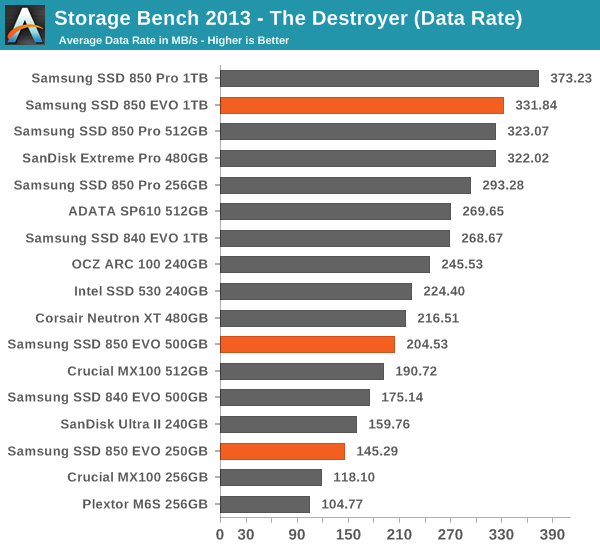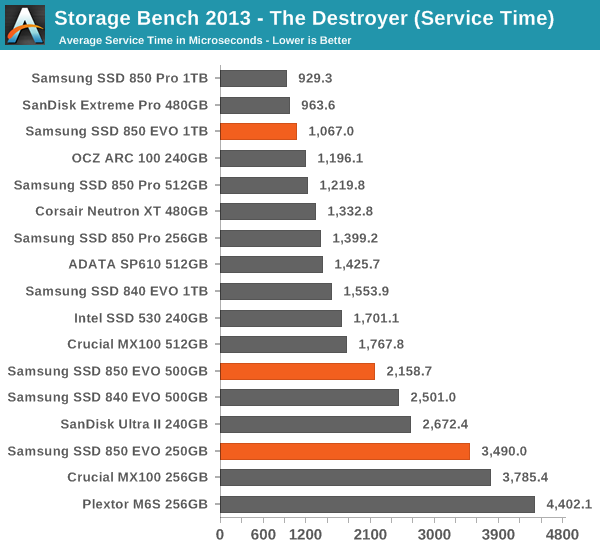Samsung SSD 850 EVO (120GB, 250GB, 500GB & 1TB) Review
by Kristian Vättö on December 8, 2014 10:00 AM ESTAnandTech Storage Bench 2013
Our Storage Bench 2013 focuses on worst-case multitasking and IO consistency. Similar to our earlier Storage Benches, the test is still application trace based – we record all IO requests made to a test system and play them back on the drive we are testing and run statistical analysis on the drive's responses. There are 49.8 million IO operations in total with 1583.0GB of reads and 875.6GB of writes. I'm not including the full description of the test for better readability, so make sure to read our Storage Bench 2013 introduction for the full details.
| AnandTech Storage Bench 2013 - The Destroyer | ||
| Workload | Description | Applications Used |
| Photo Sync/Editing | Import images, edit, export | Adobe Photoshop CS6, Adobe Lightroom 4, Dropbox |
| Gaming | Download/install games, play games | Steam, Deus Ex, Skyrim, Starcraft 2, BioShock Infinite |
| Virtualization | Run/manage VM, use general apps inside VM | VirtualBox |
| General Productivity | Browse the web, manage local email, copy files, encrypt/decrypt files, backup system, download content, virus/malware scan | Chrome, IE10, Outlook, Windows 8, AxCrypt, uTorrent, AdAware |
| Video Playback | Copy and watch movies | Windows 8 |
| Application Development | Compile projects, check out code, download code samples | Visual Studio 2012 |
We are reporting two primary metrics with the Destroyer: average data rate in MB/s and average service time in microseconds. The former gives you an idea of the throughput of the drive during the time that it was running the test workload. This can be a very good indication of overall performance. What average data rate doesn't do a good job of is taking into account response time of very bursty (read: high queue depth) IO. By reporting average service time we heavily weigh latency for queued IOs. You'll note that this is a metric we have been reporting in our enterprise benchmarks for a while now. With the client tests maturing, the time was right for a little convergence.

The faster NAND and better IO consistency results in increased performance in our 2013 Storage Bench. The 1TB version shines in the test and isn't far from the 850 Pro, but the 500GB and 250GB models end up being middle-class performers. Especially the performance of the 250GB model is a bit underwhelming because it is beaten by the Ultra II, even though the 850 EVO should have a performance advantage thanks to V-NAND.











97 Comments
View All Comments
TheWrongChristian - Monday, December 8, 2014 - link
Performance consistency wise, the MEX controller on the 1TB drive looks better than the MGX controller on the smaller drives. I guess this is the loss of a cpu core at work, but I figure there'll be no discernible difference to the user experience.All in all, looks like a nice drive, a reasonable upgrade to the existing 840 evo drives. Just hope the V-NAND cost brings the whole price down to compelling levels as the process matures.
Solid State Brain - Monday, December 8, 2014 - link
As for the Wear Leveling Count, it might actually be taking into account that a fixed portion of the installed NAND is used in SLC mode for the TurboWrite buffer. The 120GB model has 128GiB of NAND, of which 9 GiB are used for 3 GiB TurboWrite Buffer, so that makes 119 GiB of TLC capacity for both overprovisioning and user addressable space.By the way, this also implies that because of TurboWrite these Samsung EVO SSDs (including the previous 840 EVO) have less overprovisioning space than most other SSDs.
Solid State Brain - Monday, December 8, 2014 - link
Yikes! This was not meant to be in response to TheWrongChristian.hojnikb - Monday, December 8, 2014 - link
>What I do know is that Samsung started the mass production of TLC V-NAND later, which suggests that the two aren't completely uniform. Moreover, from what I know TLC NAND requires some changes to the peripheral circuitry in order to read three bits from one cell, so while the NAND memory arrays could be alike the die size is still likely at least slightly different.Is it possible, that samsung designed 2nd gen 3D with TLC in mind (eg requred peripheral circuitry) and simply set the controller in 850PRO to use 4 states instead of 8 (so MLC). I mean, it kinda makes sense to go this way, but not the other way around....
Solid State Brain - Monday, December 8, 2014 - link
@Kristian VättöDo you have any information from Samsung about whether the TurboWrite SLC buffer also helps decreasing the write amplification like on the SanDisk Ultra II with nCache 2.0?
Kristian Vättö - Tuesday, December 9, 2014 - link
Unfortunately I don't. It was among the questions I sent but unfortunately Samsung couldn't get any of my questions answered on time for the review.Solid State Brain - Wednesday, December 10, 2014 - link
Too bad that you couldn't get an answer in time. According to my observations from other people's drives, it really looks like the Turbowrite does help on that regard. Try checking out my thread on the Memory and Storage forum.This phenomenon (write amplification just over or below 1.0x) is likely not going to show up during reviews or heavy usage since generally the drives get secure erased often and/or get hammered with writes which end up filling the Turbowrite SLC buffer.
Daniel Egger - Monday, December 8, 2014 - link
It would be nice to have some older drives in the charts to get some perspective on whether a drive would make a good upgrade choice. For an upgrade the available space and the space/price ratio are probably the most important aspects but some features or a major speed increase might sweeten the deal even more. ;)sheh - Monday, December 8, 2014 - link
Not perfect of always complete, but usable:http://www.anandtech.com/bench/SSD/65
Kvaern - Monday, December 8, 2014 - link
It's my anecdotal experience that all these awesome benchmark figures means absolutely nothing for the average user.Case in point I upgraded from an old 60GB corsair drive to an EVO840 which on paper is like twice as fast as the Corsair but in reality my user experience is exactly the same.